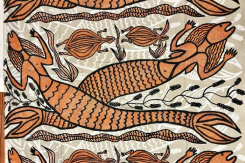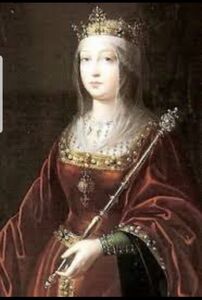History of West Phoenicia
This article is incomplete because it is pending further input from participants, or it is a work-in-progress by one author. Please comment on this article's talk page to share your input, comments and questions. Note: To contribute to this article, you may need to seek help from the author(s) of this page. |
Prehistoric History
Archaeologists have theorised through multiple archaeological site excavations, human habitation of the area now known as West Phoenicia sprung up 7000 to 8000 years ago during the Neolithic period.
Five distinct ethnic groups migrated into the region, starting from at least 8000 years ago.
The distinct ethnic groups left their mark through cities, paintings, artifacts and written and oral histories.
The Mermania
Archeological evidence discovered across a number of sites has the Mermania people migrating and settling across coastal locations of the northern and eastern coasts of modern-day West Phoenicia.
Surviving oral history transcripts compiled between 1775-1970 by Dr Richard Marcos; head of the Anthropology Department at the University of Jacksonia, strongly show Mermania settlements consisted of a matriarchal social system. The settlements were separated into family bands of up to 50 members, led by a female elder.
The Mermania people consumed freshwater or saltwater fish (depending on there location), crab and oysters. They foraged for seaweed, fruits, nuts and roots to supplement their diets.
Early Wall cave paitings discovered in northern West Phoenicia, display pictures of boat making. The Mermania became renowned for their boat making, it enabled them to venture further out into the ocean to fish and to trade with other clans on the eastern coast without having to venture inland to do so.
Jewellery was produced using pearls and shells. Jewellery was adorned by all members of the tribes and held no monetary or social status.
Due to the close proximity to water, Mermania tribe members were excellent swimmers. Oral history tells that during the Summer months, clans would come together in times of fellowship; at these events, friendly swimming competitions were held.
West Phoenician philosophers and poets have written works about the Mermania tribe descending from Mermaids and Mermen who left the oceans for land when they evolved.
The Deserti
The Deserti People, as they are referred to by historians, due to their proximity to the drier harsher territories in the central and southern parts of the region. The Desert People didn't have a singular name, rather each band was identified by their location. The more well-known tribes were "The People of the Mud River" and Desert Fox Clan.
The Desert People were renowned as fierce fighters; especially in hand to hand combat. Land border disputes and access to freshwater supplies placed tribes at odds with each other.
It was common for members of individual tribes to be aggressive towards members of their own tribes when it came to disputes over resources. Disputes were settled in hand to hand combat with the victor inflicting an injury on their opposition.
These hunter and gatherer seasonal nomads would migrate towards warmer locations during the winter months.
The Desert People resided in massive tent cities made from animal hides and wood that protected them from the elements. Desert People women were responsible for putting up and taking down the tents.
Hunting was performed by both genders. Their main sources of diet were animals like rabbits, lizards, snakes and birds. Roots, nuts and other sources of food were obtained through foraging. Foraging was handled by the children.
The tribes were split into family bands with each band controlled by a chieftain who obtained the role from a fight to the death with the previous chieftain.
Hapicuhtli, the double-faceddeity worshipped as their Supreme deity. Hapicuhtli represented Fire and Water. They were Animalistic in general.
Each year tribes held an annual sacrifice of one boy and one girl child to appease their god. One offering was burnt alive to appease the fire. The other drowned to appease the water.
The Dweorg
Cave excavations from the late 1800s have shown Dweorg Clans originally resided in the vast mountain ranges to the north at least 7,500 years ago.
It was theorised over time, clans split due to overpopulation.
A sub-group known as the Southern Dweorg migrated away from the mountains to the plains. Dwelling alongside rivers and forests. It opened up new food to these clans. The Southern Dweorgs were among the first to cultivate the land for farming.
Southern Dweorgs suffered huge losses in population. Due to their peaceful nature, they could not compete in fighting off raids from The Babalites and other nomads groups who also resided in the region and were looking to expand. Weaker clans were forced to merge with larger clans or migrate further onto the plains and into the forests to avoid the conflicts.
The Northern Dweorg remained in the mountains and caves. Ir provided a natural defence against raiders and enemy tribes.
Northern Dweorg became skilled in mining and smithing,
Northern Dweorgs became traders, setting up numerous trade routes, trading in minerals, iron and precious gems.
Leadership was in the form of a council of elders; that ruled with the use of wisdom.
Dweorgs worshipped a Supreme deity. Each household had a small alcove for their God that protected them and their home.
The Dryadi
Dryadi Tribes lived in vast territories in forests and woods throughout the northern and eastern parts of the region where the temperatures were cooler.
The northern tribes resided in mud lodges on the earth. While the eastern clans settled in the trees in elaborate tree houses. The dwellings allowed the tribes to blend in with their surroundings.
Naturalists at heart they dressed in what they could find in their locations. Leaves, ivy vines, flowers and the furs of deceased animals were popular choices. They would use berries and other sources to dye their hair and faces.
They respected nature and showed care to animals and trees. They were peaceful clans and opposed warfare. However, they practised self-defence, if required to defend themselves
Dryadi tribes lived off the land, consuming fruits, vegetables, nuts; they were primarily vegetarian by nature. However, some tribes would consume the carcass of a dead animal if it meant not starving.
They practised Animism, a belief that all living things have a soul. Tribes were led by a shaman who sought guidance by communicating with the spirits surrounding through trance and divination.
Upon death, tribe members were burnt on funeral pyres. Their ashes mixed with water and poured onto the earth.
The Babalites
The Babalites were a large group of wanderers who upon arrival in the region settled first in the plains. Historians tend to agree they were the last of the five groups to settle in the region.
Within 200 years of settling, they became great horse riders and were skilled in the use of bows and arrows, shields and spears and later swords when iron was introduced to the region through trade and raiding.
To the other ethnic groups in the region, they were commonly referred to as barbarians, due to their warlike nature.
They built established settlements and cities as they expanded. Warriors were sent out on a seasonal basis raiding villages for resources they could not grow or create themselves.
The leadership of each tribe consisted of a Lord or Lady. As time progressed these leaders built fortified castles to protect themselves and their citizens from other Babelite cities.
A hierarchal system was established; farmers and shepherds at the bottom followed by the military, the priest class and finally the nobility class.
Many modern West Phoenicians are predominantly descended from the Babalites.
Classical Era(600 BC-476 AD)
The Middle Ages (500 AD -1450 AD
Formation of The Greater Phoenician Empire
Members of a noble Babalite city family, the Imperium family, rallied other Babalite cities, alongside, Dweorgs, Mermania and Dryadi tribes to avoid being conquered from foreign invaders who allied with the Deserti people.
By 1130, The House of Imperium became the founding royal house to rule over a unified country they named; The Empire of Greater Phoenicia.
Early Modern Era (1450-1750)
Civil War within Greater Phoenicia (1570 to 1580)
Before 1586, The Empire of West Phoenicia was under the control of the Greater Phoenicia Empire.
By 1565 dissatisfaction had grown against the Greater Phoenicia Empire and the tyrannical reign of the Dundas family.
Arsinoe I Dundas Virtus; Queen of Greater Phoenicia murdered her husband, King Darius Dundas II with the intent of passing the throne to her son. A backlash erupted from several provinces. Citizens had respected the king and opposed the brutality of his murder.
The Queen and her children were forced to barricade themselves in the palace, with only the palace guards for protection. Reports from witnesses during that period held that many citizens were intent to drag out the queen and murder her. Parts of the palace were set on fire to lure the royal family out.
The riots lasted 7 days. Officials were able to calm the crowds with free grain, food and beer; the bribe worked.
Queen Arsinoe I Dundas Virtus, to appease the crowds declared Prince Darius III as co-ruler with the agreement she would stay on as regent until his 18th birthday.
Within a month, the co-regents advisors convinced him that the Queen was a liability. The advisors feared she would kill King Darius Dundas III and replace him with one of his younger siblings, bestowing her more control. Darius Dundas III was rumoured to have poisoned her based on this advice with the use of deadly nightshade.
King Darius Dundas III was not as benevolent as his father. He drove the farmers to breaking point, taxing farmers 3/4 of their crops. While the lower classes starved, the aristocratic classes had an abundance of food. He drove the nation into debt by his outlandish lifestyle and his policy of raising taxes.
During the winters of 1568 and 1569 thousands of citizens died of starvation, as well as a plague that ravaged the land. Outlining Provinces were taxed heavily to pay for the import of food for people in the cities.
Rebellions sprouted up throughout the provinces. Violence flared against the military who had been dispatched to quash them.
Wealthy churches were ransacked. Members of the aristocracy even protested against King Darius Dundas III and his policies of higher taxes and levies.
King Darius Dundas III and his royalist allies sent out the military to intervene and suppress the rebellions. Citizens fought back, gaining sympathy from more influential people and provinces.
The opposition became more organised under the leadership of local leaders, military members who had defected, sympathetic clergy and members of the aristocracy. King Darius Dundas III branded them rebels and dangerous extremists.
Villages, towns and cities loyal to the rebels were burnt and ransacked.
Enemies of Greater Phoenicia took advantage of the situation by attacking provinces or assisting provinces in attacking government forces and cities. Trade routes affecting the national treasury were also attacked and plundered.
After 10 years of civil strife, diplomats from both sides reached a cease-fire agreement. Those nations who no longer wanted to be part of Greater Phoenicia were free to secede but in doing so were no longer under the protection of Greater Phoenicia.
The War of Greater Phoenicia Aggression (1589 to 1596)
In 1580, after 10 years of a bloody civil war. A number of provinces seceded from the motherland known as Greater Phoenicia.
Initially, each nation set up their own independent state. Conflicts and battles arose as each nation vied for supremacy in the region.
Between 1580 to 1585, meetings known as the Dove of Peace Conferences were held to discuss talks of unity and mutual assistance between a handful of the independent states.
By 1586 ten states agreed to merge into one country which would be named West Phoenicia.
The city of Melbourne Haven in the city-state of Jackson was designated as the nation's capital. The wealthy Dorcas family were appointed as the first royal family of the Kingdom of West Phoenicia in 1586.
From 1586 the nation underwent a massive building campaign. Melbourne-Haven became the centre of government as well as the intellectual and cultural centre of West Phoenicia.
The developing economy revolved around the agriculture sector.
By 1590 another 10 independent provinces petitioned West Phoenicia to unify; all 10 were accepted. This action sparked the War of Greater Phoenicia aggression (1592 to 1596) due to Greater Phoenicia beholding West Phoenicia as a threat to their control of the region.
Greater Phoenicia dispatched troops into nations which were still independent based on information from spies that they aligned or were planning to join West Phoenicia. Military presence was introduced to intimidate them into not merging with West Phoenicia.
Two of those nations, The Kingdom of Debney Bay and The Theocracy of Ardon both fell within 4 months after Greater Phoenicia engaged in a bloody campaign.
Theocracy of Ardon was punished severely for being the first recaptured state that had left the Empire. Cities were burnt to the ground. Those citizens who didn't flee were taken away to become slaves.
The Kingdom of South Phoenicia held out against the blockades of Greater Phoenicia which destroyed their port cities during bombardments. Before assistance could arrive to help the city-state's main cities had been razed to the ground, South Phoenicia surrendered.
The Kingdom of West Phoenicia and other nations that had seceded intervened as best they could. Ambassadors were sent on diplomatic missions, they were murdered before reaching the royal court of King Darius Dundas III.
Troops, food and supplies were sent to The Republic of Imperial Eurasia and The Kingdom of Great Philistia which were being besieged.
.King Darius Dundas III was severe in punishing those nations who had left the Greater Phoenician Empire. Any captured nation was absorbed back into the Empire, where outspoken citizens were rounded up and killed or sent to labour camps.
Diplomats from both sides agreed to an uneasy ceasefire urging for peace for the sake of the region. Soon after calling for a ceasefire the Greater Phoenicia Royal Palace was destroyed in a fire. King Darius Dundas III who was trapped inside, died.
After the death of King Darius Dundas III, his younger brother, Prince Khufu Dundas who sought more peaceful means to end the conflict rose to the throne. Greater Phoenicia reluctantly declared West Phoenicia and the remaining independent city-states to be separate nations and called for an uneasy peace.
Reign of the Dorcas Royal Family (1586-1616)
The Dove of Peace Conferences established West Phoenicia as a nation. The wealthy influential Dorcas family were selected by the nobility and clergy as the first royal family.
The Dorcas family had played an important role in aiding provinces to secede from Greater Phoenicia. Initially they were loyal supporters of the crown until they could see the injustices that were befalling. During the famine years, the family assisted farmers and the poor in there locality to avoid starvation. During the rebellion the family secretly passed resources to aid the rebellion.
During reconstruction an influx of rich and wealthy citizens, merchants and citizens migrated to West Phoenicia boosting the economy with their business.
The Dorcas family under the leadership of KingRichard Dorcas III and Queen Consort Helena Dorcas set the nation of West Phoenicia in a positive direction.
Agriculture sectors started to grow, transforming the cities around them through massive building projects and beautification.
Before the completion of the royal place which was funded by Dorcas finances, the King and Queen were assassinated in 1590 during a harvest festival, the culprit was a Greater Phoenicia supporter.
Greater Phoenicia denied they were involved. The assassin committed suicide before he could reveal who had hired him.
Richard Dorcas III son Prince Constantine I ascended to the throne.
King Constantine Dorcas I led the military during the War of Greater Phoenicia Aggression where he died in battle in 1595 during the Battle of New Tudor
Princess Louisa Dorcas, the only living heir of the late King Richard Dorcas III assumed control of the throne and dealt with the ceasefire with Greater Phoenicia.
After completing the royal palace, major construction moved on to rebuilding all of the city states. Her goal was too make West Phoenicia the envy of the world.
She increased taxes which was not supported by alot of citizens. The money was used to build up the cities that was destroyed during the War with Greater Phoenicia. She constructed harbours and increased trade with neighbours.
New cities, schools, churches and businesses were created under her reign. As well as theatres, arenas, zoos and national gardens. She built statues in all major cities honouring her deceased parents and other heroic figures who had helped form the nation of West Phoenicia.
Queen Louisa Dorcas was criticized by the working class when she bestowed over 3000 nobility titles on the rich and wealthy. To appease the nations poor and working class she increased the number of festivals in West Phoenicia. Days which the working class could take off from their jobs, and supplied with free alcohol, food and entertainment.
Her government advised she marry and secure an heir. It was during this time that the noble family of Bush vied for more power. When the advances of one of the Bush men was not reciprocated rumours begun to pass around that Queen Louisa planned to marry a member of the Greater Phoenicia royal family and unite both nations again.
The Bush family led the charge starting riots across West Phoenicia calling for the Queen and her line to abdicate and pass the throne to a more Pro-West Phoenicia family. When the rumours could not be disproved, members of the church and various nobility sided with the Bush family.
When a church was burnt to the ground by Greater Phoenicia pirates in one of the city-states and Queen Louisa did not step up to act, her popularity and support dwindled. The Bush family organised rallies from all social classes asking for the Queen to step down. The current Pontifex declared the Bush family the new royal family saying it was God's will.
Queen Louisa was prepared to fight for the throne but was advised she needed to do what was best for the country so she abdicated in 1615, where she was given land and made Grand Duchess of West Phoenicia.
Rise of the Bush Royal Family (1616-)
Baron Glenton Bush I became King Glenton Bush I Soter in 1616 after the abdication of Queen Louisa Dorcas. He was 40 at the time of his coronation and was married to Baroness Brenda the elder who became Queen Brenda I Bush Soteria
The titles Soter and Soteria meaning Saviours were bestowed upon them by the church and the citizens.
Many citizens in West Phoenicia believed they had been saved from being united with Greater Phoenicia.
This was the starting of a dynasty which is still on the throne today.
The Royal Family lowered taxes to garnish the support from the poor and working classes,but continued a building campaign that would make West Phoenicia the envy of the world in Science, Philosophy, The Arts and Agriculture.
They married off their children to neighbouring kingdoms to strengthen political alliances through marriage. To keep the royal bloodline pure also encouraged intermarriage of siblings.














